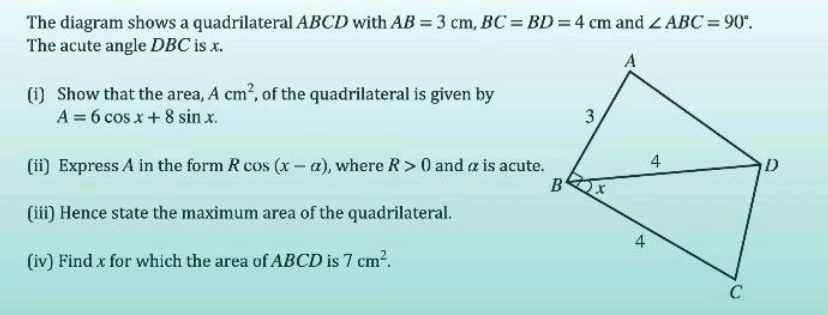Question Number 187253 by Rupesh123 last updated on 15/Feb/23

Answered by MikeH last updated on 15/Feb/23

$$\left(\mathrm{i}\right)\:\mathrm{Area}\:\mathrm{of}\:\bigtriangleup{BCD}\:=\:\frac{\mathrm{1}}{\mathrm{2}}\left(\mathrm{4}\right)\left(\mathrm{4}\right)\:\mathrm{sin}\:{x}\:=\:\mathrm{8}\:\mathrm{sin}\:{x} \\ $$$$\:\:\:\:\:\:\:\mathrm{Area}\:\mathrm{of}\:\Delta{ABD}\:=\:\frac{\mathrm{1}}{\mathrm{2}}\left(\mathrm{3}\right)\left(\mathrm{4}\right)\mathrm{sin}\:\left(\mathrm{90}−{x}\right)\:=\:\mathrm{6}\:\mathrm{cos}\:{x} \\ $$$$\mathrm{total}\:\mathrm{area}\:=\:\mathrm{area}\:\mathrm{of}\:\Delta{BCD}\:+\:\mathrm{area}\:\mathrm{of}\:\Delta{ABD} \\ $$$$\Rightarrow\:{A}\:=\:\mathrm{6}\:\mathrm{cos}\:{x}\:+\:\mathrm{8}\:\mathrm{sin}\:{x}\:\blacksquare \\ $$
Commented by Rupesh123 last updated on 15/Feb/23
Good job!
Answered by MikeH last updated on 15/Feb/23

$$\left(\mathrm{ii}\right)\:{A}\:=\:{R}\:\mathrm{cos}\left({x}−\alpha\right)\: \\ $$$$\Rightarrow\:\mathrm{6}\:\mathrm{cos}\:{x}\:+\:\mathrm{8}\:\mathrm{sin}\:{x}\:\equiv\:{R}\mathrm{cos}\:{x}\:\mathrm{cos}\:\alpha\:+\:{R}\mathrm{sin}\:{x}\:\mathrm{sin}\:\alpha \\ $$$$\Rightarrow\:{R}\mathrm{cos}\:\alpha\:=\:\mathrm{6}…..\left(\mathrm{1}\right) \\ $$$$\:\:\:\:\:\:{R}\:\mathrm{sin}\:\alpha\:=\:\mathrm{8}…..\left(\mathrm{2}\right) \\ $$$$\left(\mathrm{1}\right)^{\mathrm{2}} +\left(\mathrm{2}\right)^{\mathrm{2}} \:\: \\ $$$$\Rightarrow\:{R}\:=\:\sqrt{\mathrm{6}^{\mathrm{2}} +\mathrm{8}^{\mathrm{2}} }\:\:=\:\mathrm{10} \\ $$$$\:\left(\mathrm{2}\right)/\left(\mathrm{1}\right)\:\Rightarrow\:\:\mathrm{tan}\:\alpha\:=\:\frac{\mathrm{4}}{\mathrm{3}}\:\Rightarrow\:\alpha=\:\mathrm{53}.\mathrm{13}° \\ $$$$\begin{array}{|c|}{{A}\:=\:\mathrm{10}\:\mathrm{cos}\left({x}\:−\:\mathrm{53}.\mathrm{13}°\right)}\\\hline\end{array} \\ $$
Answered by MikeH last updated on 15/Feb/23

$$\left(\mathrm{iii}\right)\:\mathrm{maximum}\:\mathrm{area}\:\mathrm{occurs}\:\mathrm{when}\:\mathrm{cosine}\:\mathrm{is} \\ $$$$\mathrm{maximum} \\ $$$$\Rightarrow\:{max}\:{A}\mathrm{rea}\:=\:\mathrm{10}\:\mathrm{cm}^{\mathrm{2}} \\ $$
Answered by MikeH last updated on 15/Feb/23

$$\left(\mathrm{iv}\right)\:{A}\:=\:\mathrm{10}\:\mathrm{cos}\:\left({x}−\mathrm{53}.\mathrm{13}°\right) \\ $$$${A}\:=\:\mathrm{7} \\ $$$$\Rightarrow\:\mathrm{cos}\:\left({x}−\mathrm{53}.\mathrm{13}°\right)\:=\:\frac{\mathrm{7}}{\mathrm{10}} \\ $$$$\Rightarrow\:{x}−\mathrm{53}.\mathrm{13}°\:=\:\:\mathrm{360}°{n}\pm\mathrm{45}.\mathrm{57}\: \\ $$$$\Rightarrow\:{x}\:=\:\mathrm{360}°{n}\:\pm\mathrm{45}.\mathrm{57}\:+\:\mathrm{53}.\mathrm{13} \\ $$$$\mathrm{0}°\leqslant{x}\:<\mathrm{90}°\:\:\Rightarrow\:{n}\:=\:\mathrm{0}\:\Rightarrow\:{x}\:=\:\mathrm{7}.\mathrm{56}° \\ $$
Commented by Rupesh123 last updated on 15/Feb/23
Good my friend!
